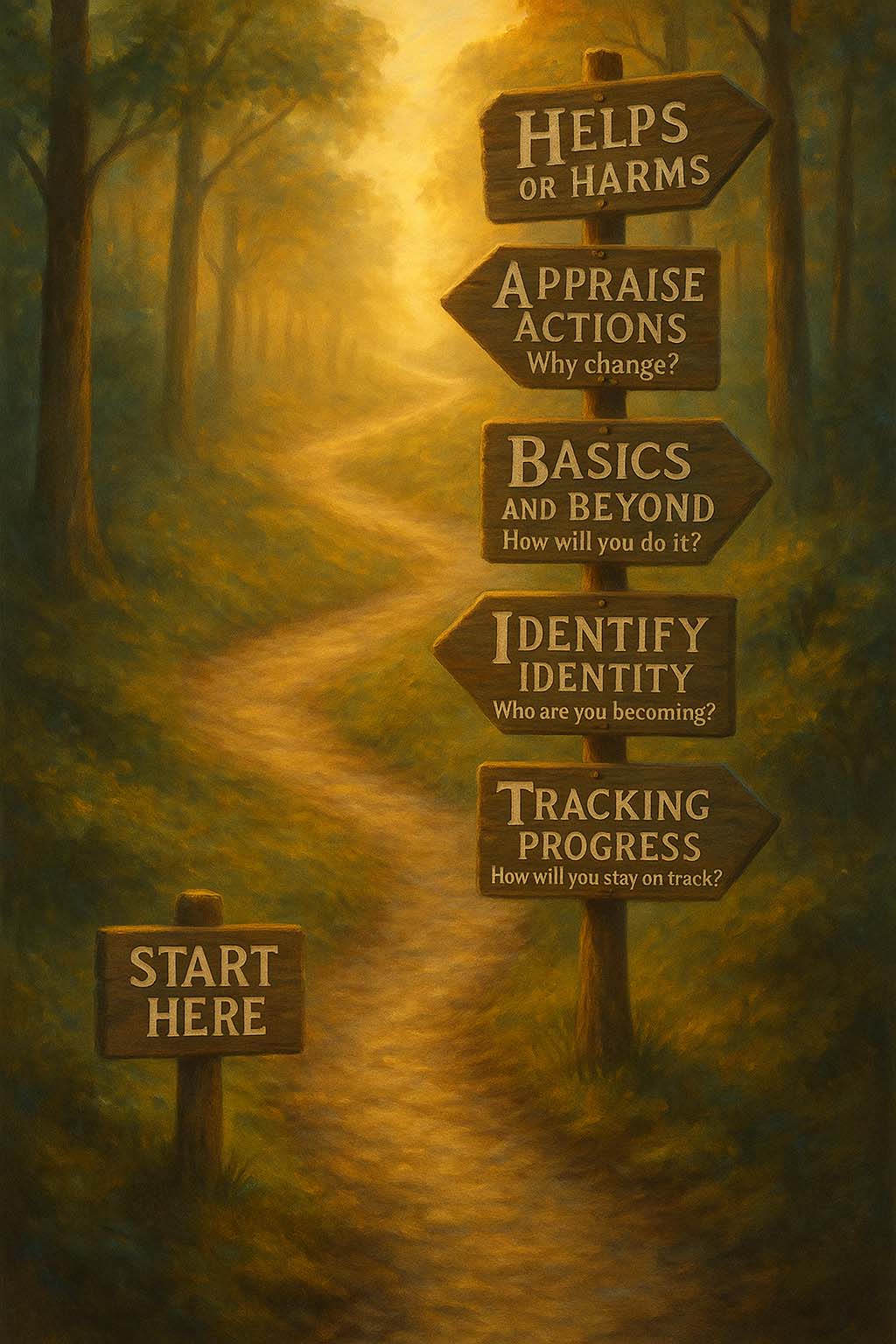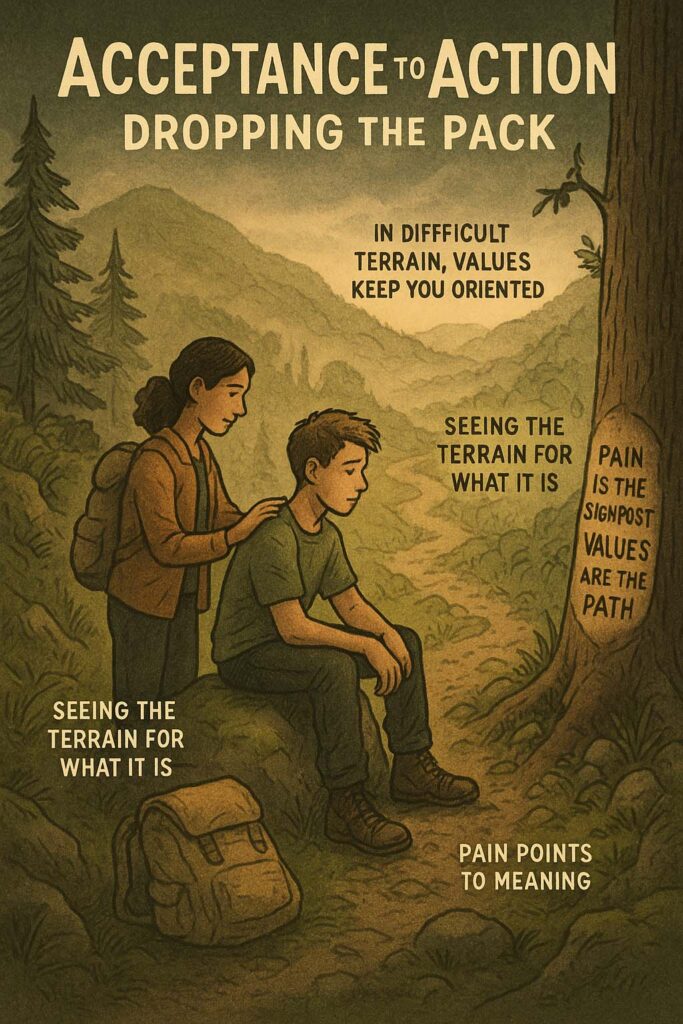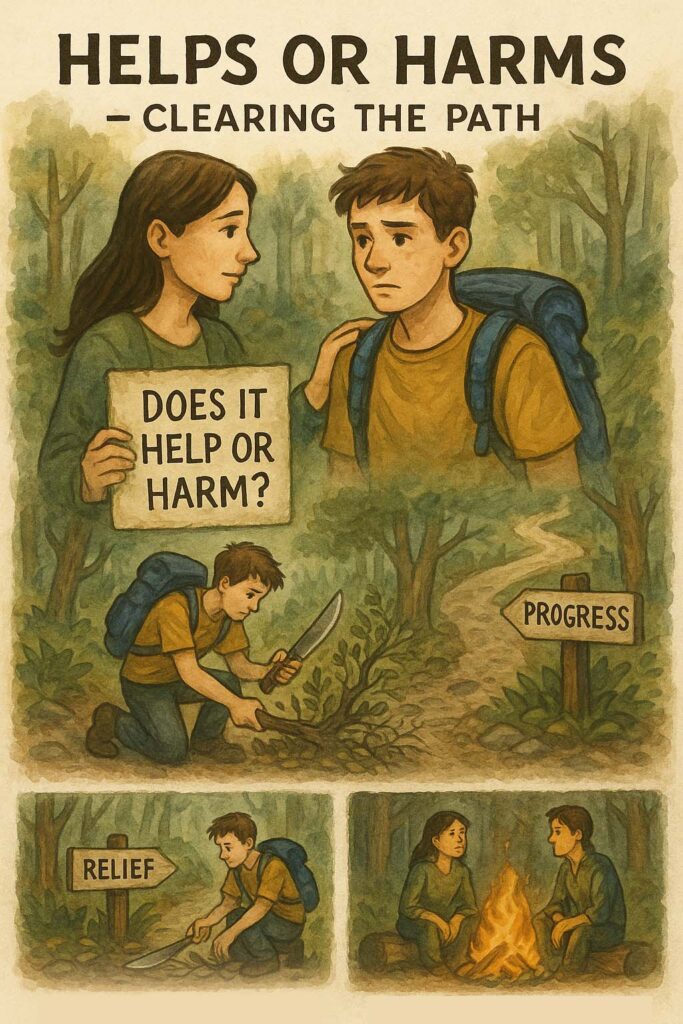
The HABIT Framework
For those of us with ADHD, change doesn’t begin with grand plans. It begins in the moment—often in the pause between impulse and action. But habits don’t form by accident. They’re shaped by choices we return to, again and again. The HABIT framework is designed to help you build habits that reflect who you are, what you care about, and how you want to show up in life. Each letter offers a new lens through which to understand and shape your habits—so they don’t just stick, they mean something.
Let’s walk through the framework.
H – Helps or Harms
What daily behaviours support or sabotage this habit?
This step is about surfacing the micro-habits—those small, often invisible routines—that either help your target habit take root or keep pulling you away from it. It also asks you to reflect on the systems, contexts, and triggers that shape your choices.
Questions to consider:
- What actions, environments, or routines make this habit easier for me?
- What gets in the way—distractions, emotional states, temptations?
- What is the smallest thing I can tweak today to give this habit a better chance of sticking?
Example: If your goal is to go to bed by 10 p.m., staying on your phone after nine might harm this habit. A warm shower and dimmed lights after dinner might help.
A – Appraise Motivation
Why do I want this habit? And how will it ripple across my life?
Here, you appraise the ‘why’ behind the habit—not just logically, but meaningfully. How does this habit support your well-being across the four life domains: work or study, relationships, leisure, and health/growth?
This is not about obligation. It’s about connecting your habit to your values, goals, and needs—so it feels worth returning to even when motivation dips.
Questions to consider:
- What values or goals does this habit support?
- How would this habit impact each life domain?
- What deeper need does it meet—freedom, calm, connection, mastery?
B – Basics and Beyond
What strategies give this habit the best chance to grow?
This is where the science of habit formation lives. Drawing from behavioural science, this step helps you explore how to create reliable cues, shrink resistance, and design sustainable changes—whether quick wins or long-haul efforts.
Core techniques include:
- Habit stacking (linking a new habit to an existing one)
- Visual cues (notes, objects, colour-coded prompts)
- Environment design (putting supports in easy reach)
- Friction management (removing temptations, reducing complexity)
Questions to consider:
- Can I shrink the first step?
- What tools or reminders could help?
- Is there a time of day this naturally fits?
I – Identity and Values
What kind of person do I want to be—and how does this habit reflect that?
This step grounds the habit in your evolving self-concept. You’re not just trying to meditate—you’re becoming a calmer person. Not just exercising—you’re becoming someone who honours energy and health.
And beneath identity lie values. What qualities do you want to bring to your actions? Who do you want to be in your family, your work, your community?
Questions to explore:
- What value does this habit express? (e.g. patience, care, courage, consistency)
- What kind of person am I trying to become?
- What do I want to stand for, especially when it’s hard?
- How does this habit help me show up for the people I care about?
T – Track Progress
How will I know if the habit is taking root—and how will I course-correct?
Change needs feedback. This step invites you to notice what’s working, celebrate small wins, and adjust your plan with self-compassion when things slip. It’s not about perfection—it’s about reflection and resilience.
Ideas for tracking:
- A simple daily check mark
- Journaling: “Did I follow through? What helped/hurt?”
- Weekly reflections: “Where was I consistent? Where did I drift?”
- Visual charts, stickers, or reward systems
Key point: Tracking is not just accountability—it’s awareness. It shows you where your river flows smooth, and where rocks still catch the current.
🧭 The HOPE Trail Map
- Helps or Harms: Am I tapping into strength—or just forcing myself to push through at any cost?
- Own My Values: I want to be someone who honours what I carry, and still chooses to move forward.
- People and Pursuits: Who strengthens my resolve without demanding my perfection? What goals are worth holding steady for?
- Enact and Evaluate: Today, I’ll notice one place I’ve stayed strong—even if I didn’t feel it at the time.
⚠️ Trail Challenges
- Constant setbacks may erode belief in one’s own strength.
- Emotional intensity can feel like weakness instead of sensitivity.
- ADHDers may confuse pushing through with true inner strength.
🪧 Trail Markers: Small Steps Toward Fortitude
- Write a “strength story” about a time you endured more than you thought you could.
- Say: “This is hard, and I’m doing it anyway.”
- Practice pausing instead of quitting—rest is part of strength.
🔥 Campfire Questions for Reflection
- When have I shown fortitude, even when no one else knew?
- What helps me stay upright when life feels overwhelming?
- How can I honour the strength it takes to simply stay present in the discomfort?
Fortitude is not loud. It’s the still voice inside that says, “You’ve made it through worse—and you’re still here.”



